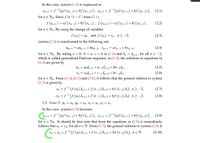
Advanced Engineering Mathematics
10th Edition
ISBN: 9780470458365
Author: Erwin Kreyszig
Publisher: Wiley, John & Sons, Incorporated
expand_more
expand_more
format_list_bulleted
Question
Show me the steps of determine green and all information is here step by step

Transcribed Image Text:In this case, system (1.8) is expressed as
Xn+1 = f (af (xn-1) +bf (xp-2)), yn+1 =ƒ'(af (ya-1) +bf (yn-2)), (2.1)
for n E No. Since f is "1 – 1", from (2.1)
f (Xn+1) = af (xn-1) +bf (xn-2), ƒ (Vn+1) = af (Yn-1)+bf (yn-2),
(2.2)
for n e No. By using the change of variables
f (xn)
= Un, and f (yn) =
= Vn, n> -2,
(2.3)
system (2.2) is transformed to the following one
Un+1 = aun-1+bun-2, Vn+1 =avn-1+bvn–2,
(2.4)
for n E No. By taking a = 0, b=a, c=b in (1.4) and S, = Jn+1, for all n > -2,
which is called generalized Padovan sequence, in (1.5), the solutions to equations in
(2.4) are given by
Un = uoJn+1+u_jJn+2+bu_2Jn,
(2.5)
Vn = VoJn+1 +v_jJn+2+bv_2Jn;
(2.6)
for n e No. From (2.3), (2.5) and (2.6), it follows that the general solution to system
(2.2) is given by
Xn = f(f (x0) Jn+1+f (x=1)Jn+2+bf (x-2)Jn), n> -2,
Yn = f(f (yo) Jn+1+f (y-1)Jn+2+bf (y-2) Jn), n2 -2.
(2.7)
(2.8)
2.2. Сase 2: pn — Хп, qn — Xп, Гn — Xn, Sn — Xn
In this case, system (1.8) becomes
Xn+l=f (af (xn-1)+bf (xp–2)), Yn+1=f"(af (xn-1)+bf (xp-2)), (2.9)
for n e No. It should be first note that from the equations in (2.9) it immediately
follows that x, = yn, for all n E N. From (2.7), the general solution to system (2.9) is
Xn = Yn = f¯' (f (xo) Jn+1+f (x_1)Jn+2+bf (x_2)Jn), nE N.
(2.10)

Transcribed Image Text:The equation
axn-Xn-k
Xn+1 =
nE No,
(1.1)
bxn-p±cXn-q
where the initial conditions are arbitrary positive real numbers, k, 1, p, q are non-
negative integers and a, b, c are positive constants, is one of the difference equations
whose solutions are associated with number sequences. Positive solutions of concrete
Motivated by this line of investigations, here we show that the systems of differ-
ence equations
Xn+1 =f'(af (Pn-1)+bf (qn-2)), yn+1 =f'(af (rn-1)+bf (Sn-2)), (1.8)
for n E No, where the sequences Pn, qn, Tn and Sn are some of the sequences xn and
Yn, f : Df → R is a "1 – 1" continuous function on its domain Df CR, the initial
values x-j, y-j, je {0,1,2} are arbitrary real numbers and the parameters and a, b
Expert Solution
This question has been solved!
Explore an expertly crafted, step-by-step solution for a thorough understanding of key concepts.
Step by stepSolved in 2 steps with 2 images

Knowledge Booster
Similar questions
- Where are the follow up steps (step 4-7)?arrow_forwardArrange these steps in the correct order to prove that if you have an 8-gallon jug of water and two empty jugs with capacities of 5 gallons and 3 gallons, respectively, then you can measure 4 gallons by successively pouring some of or all of the water in a jug into another jug in the correct order. Rank the options below. Fill the 3-gallon jug from the 5-gallon jug, leaving (3, 2, 3). Empty the 5-gallon jug's contents into the 3-gallon jug, leaving (6, 0, 2), and then fill the 5-gallon jug from the 8-gallon jug, producing (1, 5, 2). Fill the 5-gallon jug from the 8-gallon jug, leaving the contents (3, 5, 0), where the ordered triple is used to record the amount of water in the 8-gallon jug, the 5-gallon jug, and the 3-gallon jug, respectively. Top off the 3-gallon jug from the 5-gallon jug, and there will be (1, 4, 3), with four gallons in the 5-gallon jug. Pour the contents of the 3-gallon jug back into the 8-gallon jug, leaving (6, 2, 0). ❤ ← ←arrow_forwardTranslate the point 8 units right and 5 units downarrow_forward
arrow_back_ios
arrow_forward_ios
Recommended textbooks for you
 Advanced Engineering MathematicsAdvanced MathISBN:9780470458365Author:Erwin KreyszigPublisher:Wiley, John & Sons, Incorporated
Advanced Engineering MathematicsAdvanced MathISBN:9780470458365Author:Erwin KreyszigPublisher:Wiley, John & Sons, Incorporated Numerical Methods for EngineersAdvanced MathISBN:9780073397924Author:Steven C. Chapra Dr., Raymond P. CanalePublisher:McGraw-Hill Education
Numerical Methods for EngineersAdvanced MathISBN:9780073397924Author:Steven C. Chapra Dr., Raymond P. CanalePublisher:McGraw-Hill Education Introductory Mathematics for Engineering Applicat...Advanced MathISBN:9781118141809Author:Nathan KlingbeilPublisher:WILEY
Introductory Mathematics for Engineering Applicat...Advanced MathISBN:9781118141809Author:Nathan KlingbeilPublisher:WILEY Mathematics For Machine TechnologyAdvanced MathISBN:9781337798310Author:Peterson, John.Publisher:Cengage Learning,
Mathematics For Machine TechnologyAdvanced MathISBN:9781337798310Author:Peterson, John.Publisher:Cengage Learning,


Advanced Engineering Mathematics
Advanced Math
ISBN:9780470458365
Author:Erwin Kreyszig
Publisher:Wiley, John & Sons, Incorporated

Numerical Methods for Engineers
Advanced Math
ISBN:9780073397924
Author:Steven C. Chapra Dr., Raymond P. Canale
Publisher:McGraw-Hill Education

Introductory Mathematics for Engineering Applicat...
Advanced Math
ISBN:9781118141809
Author:Nathan Klingbeil
Publisher:WILEY

Mathematics For Machine Technology
Advanced Math
ISBN:9781337798310
Author:Peterson, John.
Publisher:Cengage Learning,

